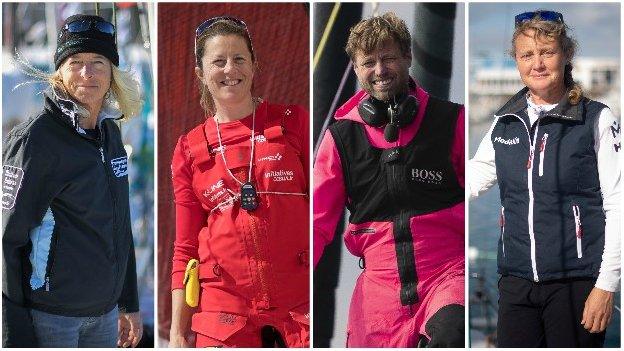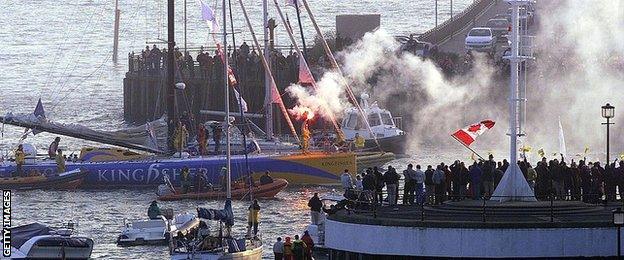Vendee Globe: The race to the end of the world
- Published

Miranda Merron, Sam Davies, Alex Thomson and Pip Hare (left to right) are representing Great Britain in the 2020-21 race
This Sunday the ninth edition of the Vendee Globe, one of the longest and most punishing races in the world, gets under way.
The concept is simple.
Each competitor must sail alone and continuously around the planet.
They can drop anchor, but they cannot return to dry land or receive assistance from another boat.
The one exception is when one competitor rescues another. Given the route takes the race through the Southern seas and far from the nearest assistance, their rivals are often their best hope of rescue.
Pete Goss was awarded the Legion d'Honneur - France's highest honour - after risking his own life by turning back into a Southern Ocean hurricane to rescue French sailor Raphael Dinelli in the 1996-97 race, external, while fellow Briton Sam Davies went to the aid of another French sailor while competing in 2008.
The race happens every four years. It starts and ends in Les Sables d'Olonne on France's Atlantic coast. The journey covers 24,000 nautical miles and was completed in a record 74 days, three hours and 35 minutes by Frenchman Armel Le Cleac'h in 2017.
All the boats that take part are 60 feet long and the most advanced can reach speeds of 30 knots (about 35mph) in downwind conditions.
The contenders

Some of the most technically advanced boats in the world are gathered at Les Sables d'Olonne
More people have walked on the moon, than women have competed in the Vendee Globe.
However this year, six female skippers will take be among the 33-strong field, three of whom are Britons.
Pip Hare, Miranda Merron and Sam Davies all spoke to BBC Radio Four's Women's Hour last week.
"We have satellite phones so we can stay in touch, but we escape a lot and we live in our own little bubble out there to sail safely and survive all the challenges that are thrown at us," explained Davies, who finished fourth in the 2008-09 race.
"There are moments where you have to be 100% focused just to keep your life out of danger."
Merron is making her debut in the race, but has completed two stages of the Volvo Ocean Race and attempted the Trophy Jules Verne, a crewed round-the-world attempt.
"It will take me about three months because I have an older boat. Given the state of affairs on land, I am absolutely thrilled to be going away for quite a long time," she said.
"The Atlantic is generally a bit easier than the Southern Indian and Southern Pacific. Having been in the Southern Ocean before, it is not really a place for mankind, it is a long way from anything and if something goes wrong, your nearest help will almost certainly be a fellow competitor."
"One of the interesting and incredible things about the Vendee Globe is the range of entries and projects," added Hare, who has a professional sailing career spanning 25 years.
"There are 33 entries and the age of the boats spans about 20 years. We all have our own stories and it is about the ability to keep on going on.
"It becomes more about what is in your head than your physical ability and that is why men and women can compete on equal terms.
"There is one person managing a 60-foot boat with a sail area that can cover three tennis courts. You are constantly moving. The brain has to regulate, risk assess and problem solve. It is a unique set of qualities you need and it is so much more than physical."
Compatriot Alex Thomson, on board Hugo Boss, is one of the favourites for this year's race having finished second in 2017 and third in 2013. His top-three finishes followed retirements from the 2004-05 and 2008-09 races.
The course

Ellen MacArthur finished second in 2001
The difference that sets apart the fastest competitors is the way they pick between high and low pressure to optimise the wind conditions.
The field strike south after leaving the Bay of Biscay, skirting around the west coast of north Africa, rounding the Cape of Good Hope, passing south of Australia and New Zealand, coming round Cape Horn at the south tip of South America before heading north back up the Atlantic to France.
The route involves passing through the 'doldrums' - a belt around the Equator characterised by light winds that can leave boats struggling to make progress.
The history
The event has been characterised by extreme danger and extraordinary feats of endurance.
In 2001 Britain's Ellen MacArthur was greeted by crowds of 200,000 people after she became the youngest person and fastest woman to complete the race, aged 24., external
Four years before, her compatriot Tony Bullimore was presumed to have died when his boat was found capsized after encountering 100mph winds, 1,500 miles off the coast of Australia.
However the then 57-year-old survived in an airpocket of the upturned hull, living off chocolate bars for four days before being rescued by the Australian navy.
In 1997, Tony Bullimore was rescued after four days under the hull of his capsized boat.
Others have been less fortunate. Briton Nigel Burgess is one of three men lost at sea in the race or on the way to the startline.
In the average Vendee Globe race, only around 55% of entrants will finish, with others being forced to withdraw because of damage sustained in rough conditions.